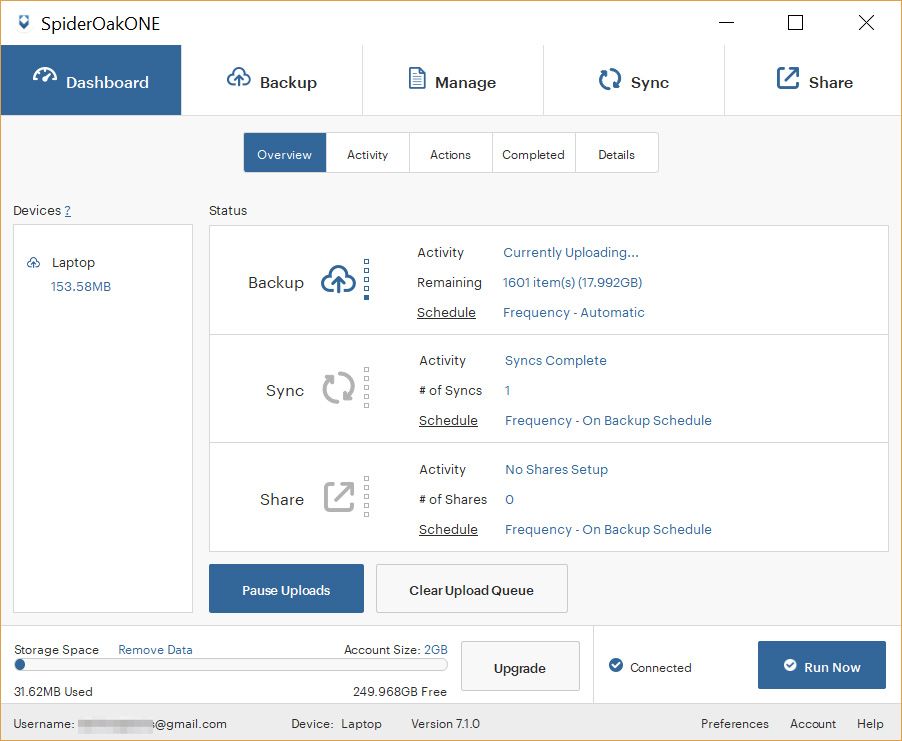

Also, the ShareRooms require that the folders you share be decrypted with your key, and stored using SpiderOak-provided security for as long as they are shared.
#Spideroak cost password#
In both cases, SpiderOak says it doesn’t store the password on disk or retain it longer than is needed for the task.
#Spideroak cost download#
The only points of weakness are when you create your account on SpiderOak’s servers, since you must enter the password at that time, and if you use the Web to view or download files.

If you lose the password, you’re out of luck but if, say, your computer melts down, you can recover backups from another system so long as you know the password.ĬrashPlan ( ) offers a couple of variants on this option, one essentially identical SpiderOak’s, and another in which the encryption key itself is generated and stored by the user, with no hope of recovery if lost. SpiderOak also stores the key on its servers in such a way that it can’t gain access to the key without your password.

SpiderOak generates a private encryption key for you the first time you run the client software, and your password locks that key locally. One folder can be on the machine you’re working on, and another, named something different, maybe elsewhere in the backup set of computers you’ve added to your account or on the same machine, for syncing to an external volume or a local network’s volume. SugarSync and others), SpiderOak lets you pick two arbitrary folders on distinct locally available or network locations. Rather than having a single anointed folder (as withĭropbox ), or picking identical folders on multiple machines (as with The approach SpiderOak takes to sync is interesting.
#Spideroak cost mac#
There’s even a prominent Pause All Uploads button on the Status tab.īackup Selection: The selection dialog box appeals more to Unix geeks than Mac users, as it shows all files and folders, but it also allows a more informed set of backup choices. If your broadband throughput is limited, this variety of options helps keep your network from becoming clogged. You can also specify the frequency for backup, sync, and sharing operations separately-anywhere from Automatic to a set time. Most welcome are options like “Don’t backup files larger than” a specified number of megabytes, and the ability to exclude files by wildcards, such as *.log or *.zip. SpiderOak provides a host of backup tweaks for those who like to restrict backups beyond just selecting certain files. Essentially, in Basic mode, you decide what gets backed up based on SpiderOak’s broad-based categories. If you switch to Basic mode, the prefab checkboxes take up the main window, and the search functions disappear. You can also search for files across your entire drive, and add external drives to the backup. Prefab checkboxes with bright colors to their left let you pick major categories in the user folder, while the main browser window provides granular selection of folders and files. The backup selection has a beautiful threaded interaction, so that as you proceed through selecting and deselecting files, the Storage Bar at the bottom calculates how many files you will place on its service-and whether you’ll need to buy more storage from SpiderOak to do so. For more-experienced users, that geekiness is an advantage, revealing otherwise-hidden folders that may contain files and nested folders that require backup when you’re not using disk mirroring (as with, say, Backupīackup Preferences: SpiderOak lets you set some fiddly backup parameters, such as excluding files over a certain size to reduce bandwidth use.The backup selection process remains as wonky as it was years ago-it feels more like a Unix directory listing than it does a Mac-style user-friendly approach to selecting files, especially when viewed in Advanced mode.

There are other rough spots, too, such as the inability to paste a password into the login field and to copy a sharing URL when its text is selected. Instead, you must select Show from the menu, which reveals a floating window that can get lost under other application windows. Though SpiderOak puts its colorful icon in the system menu bar (you can change it to black if you find it too colorful), the application doesn’t show up in the Dock. My initial nitpick is that the application doesn’t behave like an application.


 0 kommentar(er)
0 kommentar(er)
